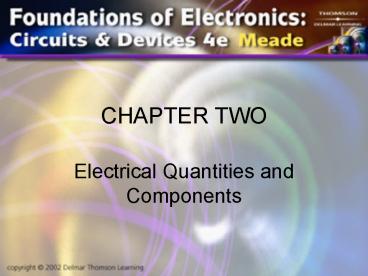CHAPTER TWO PowerPoint PPT Presentation
1 / 28
Title: CHAPTER TWO
1
CHAPTER TWO
- Electrical Quantities and Components
2
CONDUCTANCE
- Definition Ability to allow current to flow
- Relationship to Resistance Opposite of
resistance - Unit of measure Siemens
3
ELECTRICAL UNITS AND ABBREVIATIONS
- Unit Measure Symbol
- Potential Volt V
- Current Ampere A
- Resistance Ohm ?
- Conductance Siemens S
4
FAMILIAR METRICS
5
CONDUCTORS
- Function
- to carry electrical energy from one point to
another - provide a path for electrical current flow
between components or circuits - Numerous types of conductors
- type to use determined by
- nature of application
- amount of electrical energy it must carry
6
CONDUCTORS
- Ways of classifying conductors include
- type of metal used
- size of the wire itself
- form of the wire (solid, stranded, or braided)
- number of conductors used
- insulation characteristics
7
SUPERCONDUCTIVITY
- All conductors have some resistance at normal
operating temperatures - Superconductivity current flow through a
material with nearly zero resistance - Only occurs in certain materials
- Only occurs at extremely cold temperatures (e.g.,
273C)
8
SUPERCONDUCTIVITY
- Certain ceramic materials have very low
resistance at temperatures much higher than
absolute zero (273C). - low resistance at higher temperatures makes it
easier to take advantage of superconductivity - Some future possibilities
- more efficient motors, generators, and so on
- faster computers.
9
PHYSICAL FACTORS OF CONDUCTORS
- Factors that influence resistance
- type of material
- length of conductor
- cross-sectional area of wire
- temperature of wire
- temperature coefficients
10
PHYSICAL FACTORS OF CONDUCTORS
- Resistivity
- resistance in ohms of a given material per
standard length (meters or mils) and
cross-sectional area (square meters or circular
mils) - different materials have different resistivity
characteristics
11
CHARACTERISTICS OF WIRE
- Wire size and gauge
- Types and common usage
- stranded
- solid
- Current-handling capabilities and gauge
12
RESISTORS
- Definition, Purpose, Types
13
CHIP RESISTORS
- Resistors in high-density circuits
14
RESISTOR SIZE
- The physical size of the resistor determines its
ability to handle heat - The difference between a chip resistor and a
wire-wound resistor is merely its ability to
handle current flow
15
COMMON RESISTOR TYPES
- Fixed Resistors
- one value only
- common values available
- value determined by color coding
- variety of wattage rating
- quality ratings vary widely
16
VARIABLE RESISTORS
- Potentiometer
- variable from 0 Ohms to labeled value
- popular due to flexibility
- found in use as volume controls
- physical sizes available vary widely
- resistance values vary widely
- resistance value generally stamped
17
RESISTOR TYPE SUMMARY
- Wire-wound high wattage
- Potentiometer variable resistance values
- Rheostat alternative to potentiometer
- Chip resistor small size, commonly found
- Carbon composition fixed value, inexpensive
18
THE RESISTOR COLOR CODE
- Purpose Indicate value efficiently
- Values Standard values available
- Color bands Three used to indicate value
- Tolerance Fourth band to indicate
acceptable variance
19
EXAMPLE COLOR CODING
20
RESISTOR TOLERANCE
- Definition The range of acceptable values
- Common tolerance values 20, 10, 5
- Fourth band used to indicate tolerance
21
EXAMPLE OF TOLERANCE
- Resistor colors Brown, Black, Brown, Gold
- Brown, Black, Brown 100 Ohms
- Gold /-5
- Upper Limit 105 Ohms
- Lower Limit 95 Ohms
22
TYPICAL METERS
23
MEASURING VOLTAGE WITH METERS
- Check Meter Settings
- function and range
- Meter Leads
- Red, positive ()
- Black, common ()
- Connection to circuit
- Displays normal and OL or OVL
24
MEASURING RESISTANCE WITH METERS
- Remove power source
- Observe meter settings function and range
- Meter leads used like voltmeter
- Connection made across two points
- Precautions Power must be OFF
25
MEASURING CURRENT WITH METERS
- Remove power source
- Observe meter settings Change position of the
Red lead for most meters - Connection to circuit via a break in the
circuit - Precaution Connection to circuit is critical!
26
SCHEMATIC SYMBOLS
- Voltmeter
- Ohmmeter
- Ammeter
27
THE SCHEMATIC DIAGRAM
- Wiring conventions Connection/no
connection - The switch Basic On/Off
- The resistor Fixed and Variable
28
THE CIRCUIT

